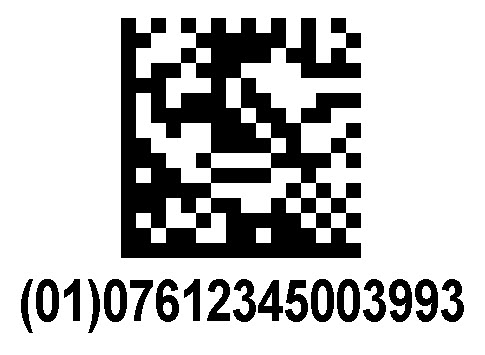The future of product labelling
2D codes enable future-oriented, efficient and innovative product labelling. They provide space for significantly more information than conventional barcodes and can be used in various areas such as logistics, healthcare or at the point of sale – for more transparency and optimisation in a wide range of applications.
What are 2D-codes?
2D codes are two-dimensional barcodes that store information both horizontally and vertically. This makes them different from conventional one-dimensional barcodes, which can only encode information horizontally. As a result, 2D codes offer significantly more storage capacity in a smaller space.
The 2D codes include the QR Code with GS1 Digital Link and the GS1 DataMatrix.
In addition to the product number (GTIN), these codes can also encode additional information such as expiry dates, batch or serial numbers and further digital content. This enables flexible and versatile use in various industries, from product labelling and traceability to increased security.
What 2D codes are there?

The QR code with GS1 Digital Link stores not only the GTIN but also web links to additional product information. This creates an interactive shopping experience and enables customers to access up-to-date information via a smartphone scan. Companies can flexibly update linked content without changing the QR code itself.

The GS1 DataMatrix is a space-saving 2D code for large amounts of data, ideal for small products and packaging. It enables the integration of serial numbers, batch and expiry dates with precise data transmission.
2D supporters in Switzerland
2D supporters worldwide
Dokumente on 2D codes
EAN/UPC barcode and 2D-Codes in comparison
| EAN/UPC-Barcode |
GS1 DataMatrix |
QR Code with GS1 Digital Link | |
|---|---|---|---|
| Encoded GTIN |
[check-orange] |
[check-orange] |
[check-orange] |
| Low space requirement | [check-orange] | [check-orange] | |
| Additional data can be encoded | [check-orange] | [check-orange] | |
| BBD control at the checkout | [check-orange] | [check-orange] | |
| Enables the use of the GTIN for variable-measure consumer units | [check-orange] | [check-orange] | |
| Additional information on allergens, ingredients, product videos, etc. | [check-orange] |
Statements from 2D code supporters
2D-Code FAQ
EAN/UPC barcodes will no longer exist from 2027. Is this true?
EAN/UPC barcodes will still be used in retail long after 2027. The goal has merely been set that by 2027 checkouts will be able to read and process 2D codes such as GS1 DataMatrix or QR code with GS1 Digital Link as a replacement for or in addition to EAN/UPC bar codes. From then on, distributors will be able to choose which code type they want to use to label their products.
Will barcodes be completely replaced by 2D codes in a few years?
No, the 2D codes mentioned will supplement or replace the conventional EAN/UPC barcodes where desired and needed.
Has this been decided independently by the standardisation organisation GS1?
GS1 is a user-driven organisation and the members determine the decisions. The decision at the GS1 Global General Assembly 2021 was taken by the presidents representing GS1 members.
It is said that conventional barcodes cannot store enough data. Is this true?
For the pure identification of products with the GS1 article number (GTIN: Global Trade Item Number), the current EAN/UPC barcodes are completely sufficient, but no additional information such as batch/lot/lot numbers, the best-before date, serial numbers etc. can be encoded in them.
When exactly does GS1 plan to introduce 2D codes?
The goal defined by GS1 Global is to enable the use of 2D codes such as GS1 DataMatrix or QR code with GS1 Digital Link as an alternative or in addition to the existing EAN/UPC barcodes at retail checkouts worldwide by the end of 2027.
EAN/UPC barcodes could co-exist with 2D codes. If there is no need to map additional information, EAN/UPC barcodes remain an option.
Is it true that no new barcodes will then be issued worldwide?
GS1 does not "assign" barcodes or 2D codes, companies license GS1 identification numbers or also GS1 basic numbers (GCP) at GS1.
Distributors assign GS1 identification numbers to their products, which can be encoded in different types of codes on the products depending on the application. These GS1 identification codes will continue to be assigned long after 2027.
Will retailers then need new scanners to read 2D codes from 2027?
To read and process 2D codes, image scanners are needed, not laser scanners. Most retail cash registers can already read 2D codes at the present time. However, depending on the initial situation, the conversion requires adjustments to hardware and software.
Please talk to your service providers and check your initial situation.
Will there be only 2D codes from 2027?
If all companies worldwide decide to use only 2D codes, this circumstance would lead to a renewed adaptation of the GS1 standards, which today allow the options mentioned. There are product categories that can probably do without additional information. This decision is primarily up to the distributor, who also assigns the GTIN.
Can I scan the new codes with my mobile phone?
It depends on which type of code is used. For the QR code with GS1 Digital Link, you do not need an app, as most mobile phones can interpret QR codes.
If the GS1 DataMatrix is used, an app is needed to scan and interpret this data.
Is it true that GS1 has not yet defined the functions that apps will provide?
GS1 does not determine what functions a third-party app will provide.
Can we talk about a revolution in barcodes?
It is an evolution that can take into account consumer demands for more information on products and at the same time meet the demands of partners in the supply chain.
In the future, information on products will only be readable by consumers via 2D codes.
The information that must be printed directly on products will be determined by the legislator.




















